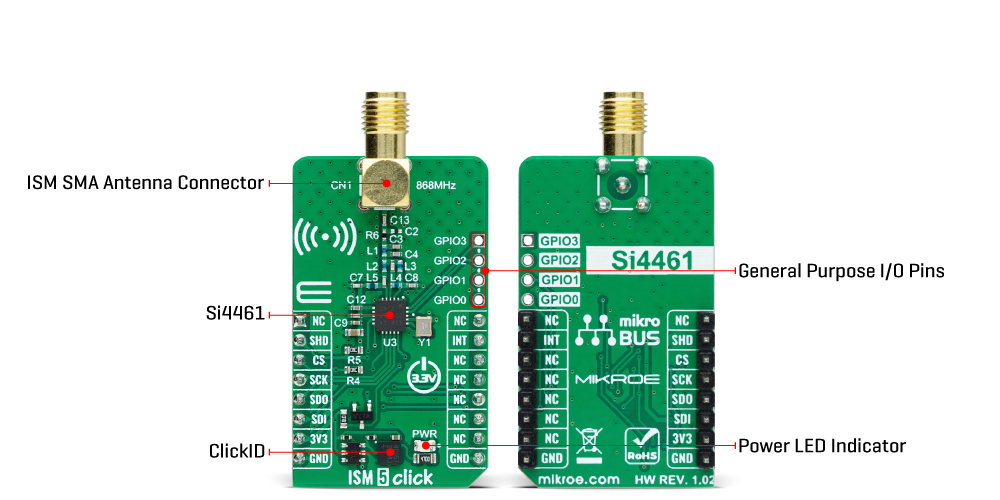OFF
GO LOCAL
| Company | Stock | Price |
|---|---|---|

MIKROE-5978
20 g
Status:
ISM 5 Click is a compact add-on board designed for seamless integration into a wide range of applications requiring efficient communication in the Sub-GHz 868MHz frequency band. This board features the Si4461, a high-performance, low-current transceiver from Silicon Labs known for its robust operation in time division duplexing (TDD) mode, enabling alternating transmission and reception of data packets. This board excels in processing signals with its support for multiple modulations, such as (G)FSK, 4(G)FSK, (G)MSK, and OOK, used by a DSP for enhanced filtering, demodulation and packet handling. Key features include exceptional receive sensitivity of -129dBm, low active and standby power consumption, and configurable data rates up to 1Mbps. This Click board™ is ideally suited for smart metering, home security, remote control, telemetry, and industrial control, offering developers a powerful tool for building advanced, energy-efficient wireless solutions.
ISM 5 Click is fully compatible with the mikroBUS™ socket and can be used on any host system supporting the mikroBUS™ standard. It comes with the mikroSDK open-source libraries, offering unparalleled flexibility for evaluation and customization. What sets this Click board™ apart is the groundbreaking ClickID feature, enabling your host system to seamlessly and automatically detect and identify this add-on board.
This product is no longer in stock
Availability date:
OFF
| Company | Stock | Price |
|---|---|---|

ISM 5 Click is based on the Si4461, a high-performance, low-current transceiver from Silicon Labs made for the Sub-GHz 868MHz frequency band. This high-performance component is designed for efficient operation in the time division duplexing (TDD) mode, seamlessly alternating between transmitting and receiving data packets. It supports a broad range of modulations, including (G)FSK, 4(G)FSK, (G)MSK, and OOK, and uses a single-conversion mixer to downconvert signals modulated by FSK/GFSK or OOK to a low intermediate frequency (IF). A programmable gain amplifier (PGA) enhances the signal before a high-performance ADC digitizes it, enabling the built-in digital signal processor (DSP) to handle filtering, demodulation, slicing, and packet management. This digital approach enhances receiver flexibility and performance compared to traditional analog systems. The demodulated data is accessible to the host MCU through a configurable GPIO on an unpopulated header or via a standard SPI bus using a 64-byte RX FIFO.

Key specifications of the Si4461 include its exceptional receive sensitivity of -129dBm and maximum output power of -16dBm. It boasts low active power consumption with ultra-low current modes with 30nA in Shutdown and 40nA in Standby. The device's synthesizer supports variable data rates from 100bps up to 1Mbps, complemented by rapid wake and hop times and a highly versatile packet handler that autonomously manages nearly any packet structure. Its dual 64-byte FIFOs for TX and RX streamline data management, making it ideal for applications such as smart metering, home security systems, remote control, telemetry, home automation, industrial control, and sensor networks.
As mentioned, the ISM 5 Click communicates with the host MCU through a standard 4-wire SPI, capable of up to 10MHz operational frequency. It also features a Shutdown mode for minimal power consumption, activated by setting the SDN pin of the mikroBUS™ socket high, and an interrupt capability, the INT pin of the mikroBUS™ socket, to signal the MCU upon specific events by setting this pin in a LOW logic state. This functionality ensures efficient power management and responsive system behavior. Moreover, the ISM 5 Click includes an SMA antenna connector for connecting a Rubber Right Angle 868MHz Antenna for optimal performance, available through the MIKROE shop.
This Click board™ can be operated only with a 3.3V logic voltage level. The board must perform appropriate logic voltage level conversion before using MCUs with different logic levels. Also, it comes equipped with a library containing functions and an example code that can be used as a reference for further development.
Type
Sub-1 GHz Transceievers
Applications
Ideal for smart metering, home security, remote control, telemetry, and industrial control, offering developers a powerful tool for building advanced, energy-efficient wireless solutions
On-board modules
Si4461 - high-performance low-current transceiver from Silicon Labs
Key Features
Multiple modulation support, exceptional receive sensitivity, low power consumption, adjustable data rates, made for 868MHz frequency band, advanced packet handling, 64-byte FIFOs, SPI interface, shutdown and interrupt feature, and more
Interface
SPI
Feature
ClickID
Compatibility
mikroBUS™
Click board size
M (42.9 x 25.4 mm)
Input Voltage
3.3V
This table shows how the pinout on ISM 5 Click corresponds to the pinout on the mikroBUS™ socket (the latter shown in the two middle columns).
| Label | Name | Default | Description |
|---|---|---|---|
| LD1 | PWR | - | Power LED Indicator |
| Description | Min | Typ | Max | Unit |
|---|---|---|---|---|
| Supply Voltage | - | 3.3 | - | V |
| Frequency Range | - | 868 | - | MHz |
| Data Rate | - | - | 1 | Mbps |
| Output Power | - | - | -16 | dBm |
We provide a library for the ISM 5 Click as well as a demo application (example), developed using MIKROE compilers. The demo can run on all the main MIKROE development boards.
Package can be downloaded/installed directly from NECTO Studio Package Manager (recommended), downloaded from our LibStock™ or found on Mikroe github account.
Library Description
This library contains API for ISM 5 Click driver.
Key functions
ism5_get_part_info This function reads the device part information.
ism5_transmit_packet This function transmits a desired data packet on the selected channel.
ism5_receive_packet This function waits for a data packet to arrive on the selected channel and reads it.
Example Description
This example demonstrates the use of an ISM 5 Click board™ by showing the communication between the two click boards (Server and Client).
void application_task ( void )
{
err_t error_flag = ISM5_OK;
static uint16_t packet_cnt = 0;
uint8_t data_buf[ ISM5_PACKET_MAX_SIZE ] = { 0 };
#ifdef DEMO_APP_SERVER
log_printf ( &logger, " Waiting for a packet message from client device...rn" );
error_flag = ism5_receive_packet ( &ism5, CHANNEL_NUMBER, data_buf, NULL, ISM5_PACKET_TIMEOUT_DISABLE );
if ( ISM5_OK == error_flag )
{
packet_cnt = ( ( uint16_t ) data_buf[ 0 ] << 8 ) | data_buf[ 1 ];
log_printf ( &logger, " Packet #%u is received with message: %srn", packet_cnt, &data_buf[ 2 ] );
Delay_ms ( 200 );
log_printf ( &logger, " Server transmits an acknowledge message to client for packet #%urnn", packet_cnt );
error_flag = ism5_transmit_packet ( &ism5, CHANNEL_NUMBER, ACKNOWLEDGE_RESPONSE, strlen ( ACKNOWLEDGE_RESPONSE ) );
}
#else
if ( ( strlen ( TEXT_MESSAGE_TO_SEND ) + 2 ) > ISM5_PACKET_MAX_SIZE )
{
log_error( &logger, " Packet exceeds maximal allowable length." );
error_flag = ISM5_ERROR;
}
if ( ISM5_OK == error_flag )
{
data_buf[ 0 ] = ( uint8_t ) ( ( packet_cnt >> 8 ) & 0xFF );
data_buf[ 1 ] = ( uint8_t ) ( packet_cnt & 0xFF );
memcpy ( &data_buf[ 2 ], TEXT_MESSAGE_TO_SEND, strlen ( TEXT_MESSAGE_TO_SEND ) );
log_printf ( &logger, " Client transmits packet #%u to serverrn", packet_cnt );
error_flag = ism5_transmit_packet ( &ism5, CHANNEL_NUMBER, data_buf, strlen ( TEXT_MESSAGE_TO_SEND ) + 2 );
}
if ( ISM5_OK == error_flag )
{
log_printf ( &logger, " Waiting for an acknowledge...rn" );
error_flag = ism5_receive_packet ( &ism5, CHANNEL_NUMBER, data_buf, NULL, ISM5_PACKET_TIMEOUT_1_SEC );
}
if ( ( ISM5_OK == error_flag ) && ( strstr ( data_buf, ACKNOWLEDGE_RESPONSE ) ) )
{
log_printf ( &logger, " Acknowledge message is received from server!rnn" );
packet_cnt++;
}
else
{
log_printf ( &logger, " Acknowledge message is NOT received from server!rnn" );
}
Delay_ms ( 1000 );
}
The full application code, and ready to use projects can be installed directly from NECTO Studio Package Manager (recommended), downloaded from our LibStock™ or found on Mikroe github account.
Other Mikroe Libraries used in the example:
Additional notes and informations
Depending on the development board you are using, you may need USB UART click, USB UART 2 Click or RS232 Click to connect to your PC, for development systems with no UART to USB interface available on the board. UART terminal is available in all MIKROE compilers.
This Click board™ is supported with mikroSDK - MIKROE Software Development Kit. To ensure proper operation of mikroSDK compliant Click board™ demo applications, mikroSDK should be downloaded from the LibStock and installed for the compiler you are using.
For more information about mikroSDK, visit the official page.
NOTE: Please be advised that any peripheral devices or accessories shown connected to the Click board™ are not included in the package. Check their availability in our shop or in the YMAN section below.